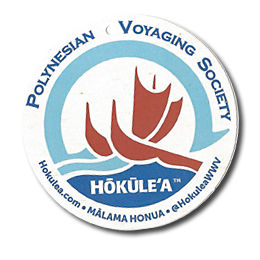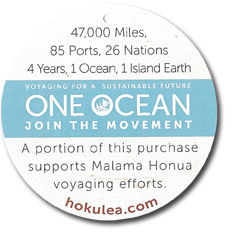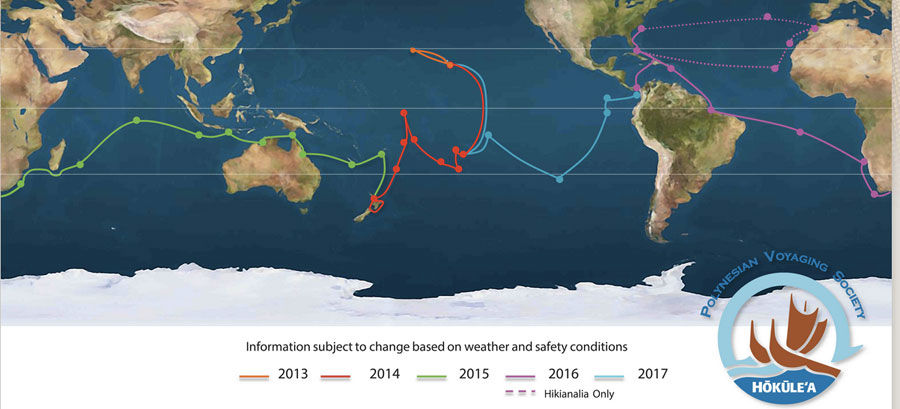Hōkūleʻa
The C4 Waterman `ohana is entwined with the history of the Hōkūleʻa and the Polynesian Voyaging Society. Some of our founders are involved
with the Polynesian Voyaging Society and have been members of the Hōkūleʻa crew: Buffalo Keaulana (1976), Brian Keaulana (1976),
Archie Kalepa (1992, 2014) and Keone Nunes (1992).
We have been recognized for our line of apparel that features the traditional Polynesian tattoo art of Keone Nunes. Through these specific
designs, that represent the culture of the voyage itself, we help spread the teachings of the “Waterman,” the core values we live by, along
with the respect we have for our natural resources and the importance of ocean conservation.
C4 has designed and created rash guards, dri-tech shirts, board shorts, hats, towels and other products with meaningful and appropriate Polynesian
tattoo art by Keone Nunes. Fifty percent of the profits from these items goes directly to the Polynesian Voyaging Society. Join us in supporting the
Polynesian Voyaging Society and the Hōkūleʻa’s World Wide Voyage and help spread Polynesian Culture and the Mālama Honua mission of taking care of
the earth and creating a sustainable planet.
Join us in support of the Hōkūleʻa when you purchase our dedicated apparel.
Click below to see these unique items created from our passion.
Click to see Hōkūleʻa apparel!
The Polynesian Voyaging Society (PVS) the Hōkūleʻa and the World Wide Voyage
Founded in 1973, the Polynesian Voyaging Society (PVS) is a non-profit research and educational corporation based in Honolulu, Hawaiʻi.
PVS was established to research and perpetuate traditional Polynesian voyaging methods. Using replicas of traditional double-hulled canoes,
PVS undertakes voyages throughout Polynesia navigating without modern instruments.
The Hōkūleʻa
On March 8, 1975, the first voyaging canoe to be built in the Hawaiian Islands in over 600 years was launched with captain Kawika Kapahulehua and crew.
Named the Hōkūleʻa, it left Hawaiʻi on May 1, 1976 for Tahiti in an attempt to retrace the ancient voyaging route. Micronesian navigator Mau Piailug, using
no instruments, successfully navigated the canoe to Tahiti, arriving there on June 3, 1976.
After an attempted voyage to Tahiti in 1978 was aborted when the Hokuleʻa capsized near Lānaʻi and crew member Eddie Aikau was lost at sea, Piailug trained
Nainoa Thompson in the ancient navigation methods. Two years later in 1980, Thompson replicated the successful 1976 voyage to Tahiti, becoming the first
modern Hawaiian to master the art of Micronesian navigation.
Since that voyage, the Hokuleʻa and her sister canoe the Hawaiʻiloa have undertaken voyages to other islands in Polynesia, including Samoa, Tonga, and New Zealand.

The World Wide Voyage

From the Hōkūle‘a website: “Hōkūle‘a and Hikianalia, our Polynesian voyaging
canoes, are sailing across Earth’s oceans to join and grow the global movement toward a more sustainable world. Covering 47,000 nautical miles, 85 ports,
and 26 countries, the Mālama Honua Worldwide Voyage will highlight diverse cultural and natural treasures and the importance of working together to protect
them. The Mālama Honua Worldwide Voyage began in 2013 with a Mālama Hawaiʻi sail around our archipelago, and will continue through 2017 when our new generation
of navigators take the helm and guide Hōkūle‘a and Hikianalia back to Polynesia after circumnavigating the globe.
“The Hawaiian name for this voyage, Mālama Honua, means “to care for our Earth.” Living on an island chain teaches us that our natural world is a gift with
limits and that we must carefully steward this gift if we are to survive together. As we work to protect cultural and environmental resources for our children’s
future, our Pacific voyaging traditions teach us to venture beyond the horizon to connect and learn with others. The Worldwide Voyage is a means by which we now
engage all of Island Earth—practicing how to live sustainably, while sharing, learning, creating global relationships, and discovering the wonders of this precious
place we all call home.”
